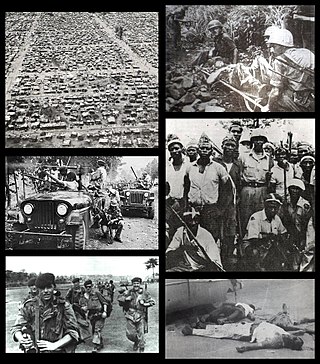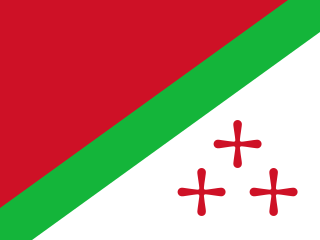The earliest known human settlements in what is now the Democratic Republic of the Congo have been dated back to the Middle Stone Age, approximately 90,000 years ago. The first real states, such as the Kongo, the Lunda, the Luba and Kuba, appeared south of the equatorial forest on the savannah from the 14th century onwards.

Sierra Leone, officially the Republic of Sierra Leone, is a country on the southwest coast of West Africa. It shares its southeastern border with Liberia, and the northern half of the nation is surrounded by Guinea. Covering a total area of 71,740 km2 (27,699 sq mi), Sierra Leone has a tropical climate, with diverse environments ranging from savanna to rainforests. The country has a population of 7,092,113 as of the 2015 census. Freetown is the capital and largest city. The country is divided into five administrative regions, which are subdivided into 16 districts.

Patrice Émery Lumumba, born Isaïe Tasumbu Tawosa, was a Congolese politician and independence leader who served as the first prime minister of the Democratic Republic of the Congo from June until September 1960, following the May 1960 election. He was the leader of the Congolese National Movement (MNC) from 1958 until his execution in January 1961. Ideologically an African nationalist and pan-Africanist, he played a significant role in the transformation of the Congo from a colony of Belgium into an independent republic.

A mercenary – also called a soldier of fortune, a hired gun, a freelance, or a sellsword – is a private individual who joins an armed conflict for personal profit, is otherwise an outsider to the conflict, and is not a member of any other official military. Mercenaries fight for money or other forms of payment rather than for political interests.

Blood diamonds are diamonds mined in a war zone and sold to finance an insurgency, an invading army's war efforts, terrorism, or a warlord's activity. The term is used to highlight the negative consequences of the diamond trade in certain areas, or to label an individual diamond as having come from such an area. Diamonds mined during the 20th–21st century civil wars in Angola, Ivory Coast, Sierra Leone, Liberia, Guinea, and Guinea-Bissau have been given the label. The term conflict resource refers to analogous situations involving other natural resources. Blood diamonds can also be smuggled by organized crime syndicates so that they could be sold on the black market.

Moïse Kapenda Tshombe was a Congolese businessman and politician. He served as the president of the secessionist State of Katanga from 1960 to 1963 and as prime minister of the Democratic Republic of the Congo from 1964 to 1965.

A private military company (PMC) or private military and security company (PMSC) is a private company providing armed combat or security services for financial gain. PMCs refer to their personnel as "security contractors" or "private military contractors".
Valentine Esegragbo Melvine Strasser is a former Sierra Leonean military officer who served as head of state of Sierra Leone from 1992 to 1996. He became the world's youngest Head of State in 1992, seizing power three days after his 25th birthday.

The Congo Crisis was a period of political upheaval and conflict between 1960 and 1965 in the Republic of the Congo. The crisis began almost immediately after the Congo became independent from Belgium and ended, unofficially, with the entire country under the rule of Joseph-Désiré Mobutu. Constituting a series of civil wars, the Congo Crisis was also a proxy conflict in the Cold War, in which the Soviet Union and the United States supported opposing factions. Around 100,000 people are believed to have been killed during the crisis.

Julius Maada Wonie Bio is a Sierra Leonean politician, and the current president of Sierra Leone since 4 April 2018. He is a retired brigadier in the Sierra Leone Army and was the military head of state of Sierra Leone from 16 January 1996 to 29 March 1996, in a military junta government known as the National Provisional Ruling Council (NPRC).

Álvaro Holden Roberto was an Angolan politician who founded and led the National Liberation Front of Angola (FNLA) from 1962 to 1999. His memoirs are unfinished.

The United Nations Operation in the Congo was a United Nations peacekeeping force deployed in the Republic of the Congo in 1960 in response to the Congo Crisis. ONUC was the UN's first peacekeeping mission with significant military capabilities and remains one of the largest UN operations in size and scope.
The Sierra Leone Civil War (1991–2002), or the Sierra Leonean Civil War, was a civil war in Sierra Leone that began on 23 March 1991 when the Revolutionary United Front (RUF), with support from the special forces of Liberian dictator Charles Taylor's National Patriotic Front of Liberia (NPFL), intervened in Sierra Leone in an attempt to overthrow the Joseph Momoh government. The resulting civil war lasted 11 years, enveloping the country. It left over 50,000 dead.
Anthony Leslie Rowland "Tony" Buckingham is a former North Sea oil-rig diver and is currently an oil industry executive with a significant shareholding in Heritage Oil Corporation. Heritage is listed on the Toronto Stock Exchange since 1999. In 2008, Heritage was listed on the London Stock Exchange. Buckingham's direct and indirect shareholding is estimated to represent 33% of Heritage. This share was reduced in November 2007 via a share placement made through JP Morgan and Canaccord.

The State of Katanga, also known as the Republic of Katanga, was a breakaway state that proclaimed its independence from Congo-Léopoldville on 11 July 1960 under Moise Tshombe, leader of the local Confédération des associations tribales du Katanga (CONAKAT) political party. The new Katangese state did not enjoy full support throughout the province and was constantly plagued by ethnic strife in its northernmost region. It was dissolved in 1963 following an invasion by United Nations Operation in the Congo (ONUC) forces, and reintegrated with the rest of the country as Katanga Province.
The Congo, short for the Democratic Republic of the Congo, is an equatorial country located in central Africa. As of July 2018, the CIA World Factbook lists the Congo containing over 85 million inhabitants representing over 200 African ethnic groups. French is the country's official language, and Catholics comprise the largest religious group at fifty percent. The Congo was colonized by King Leopold II of Belgium in 1885, and known as Belgian Congo until independence in 1960. In recent decades, the CIA has been involved in the Democratic Republic of the Congo, especially in relation to the CIA's considerations and plans to assassinate former Prime Minister Patrice Lumumba. Patrice Lumumba was the legally elected first prime minister of the independent country. Lumumba was killed on January 17, 1961, at the age of thirty-five near Élisabethville, Katanga. Even before the independence of the Congo, the U.S. government attempted to facilitate the election of a pro-western government by identifying and supporting individual pro-U.S. leaders. The CIA was also notably involved in a campaign against Lumumba's successor, which led to his eventual imprisonment and long exile from the Democratic Republic of the Congo. The CIA was also a vital part of the United States' efforts to aid Joseph Mobutu, who took control of the Congo in 1965 and renamed the country Zaire and himself Mobutu Sese Seko. The CIA would work heavily with Mobutu, particularly in relation to American support for the National Liberation Front of Angola and Jonas Savimbi's National Union for the Total Independence of Angola.

The Simba rebellion, also known as the Orientale revolt, was a regional uprising which took place in the Democratic Republic of the Congo between 1963 and 1965 in the wider context of the Congo Crisis and the Cold War. The rebellion, located in the east of the country, was led by the followers of Patrice Lumumba, who had been ousted from power in 1960 by Joseph Kasa-Vubu and Joseph-Désiré Mobutu and subsequently killed in January 1961 in Katanga. The rebellion was contemporaneous with the Kwilu rebellion led by fellow Lumumbist Pierre Mulele in central Congo.
Operation Rum Punch or Operation Rampunch was a military action undertaken by United Nations peacekeeping forces on 28 August 1961 against the military of the State of Katanga, a secessionist state from the Republic of the Congo in central Africa. UN troops arrested 79 foreign mercenaries and officers employed by Katanga with little conflict.
The Battle of Kabalo was a battle fought at Kabalo by United Nations peacekeeping forces and Baluba militias from 7 April to 11 April 1961 against mercenaries and the gendarmerie of the State of Katanga, a secessionist state rebelling against the Republic of the Congo in central Africa. The Katangese forces attacked the town as part of a larger offensive meant to restore their authority in northern Katanga which was challenged by the Baluba. A United Nations Operation in the Congo peacekeeping contingent garrisoning Kabalo, acting under the authority of their mandate to prevent civil war in the country, resisted the initial attack and arrested 30 mercenaries in Katanga's employ. Armed Baluba repelled a Katangese ferry carrying troops as well as an armoured train. The next day the ferry returned but was sunk by UN forces. Fighting continued over the next few days between the Baluba and Katangese until the latter withdrew. The battle led to a deterioration of relations between the Katangese government and the United Nations Operation in the Congo.

The Katangese Gendarmerie, officially the Katangese Armed Forces, was the paramilitary force of the unrecognized State of Katanga in Central Africa from 1960 to 1963. The forces were formed upon the secession of Katanga from the Republic of the Congo with help from Belgian soldiers and former officers of the Force Publique. Belgian troops also provided much of the early training for the Gendarmerie, which was mainly composed of Katangese but largely led by Belgians and later European mercenaries.












